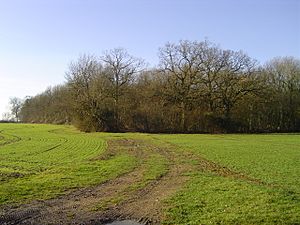Frithy and Chadacre Woods facts for kids
| Site of Special Scientific Interest | |

Frithy Wood
|
|
| Area of Search | Suffolk |
|---|---|
| Interest | Biological |
| Area | 28.7 hectares |
| Notification | 1987 |
| Location map | Magic Map |
Frithy and Chadacre Woods is a special natural area in Suffolk, England. It covers about 28.7 hectares, which is like 70 football fields! This place is so important for nature that it's called a Site of Special Scientific Interest (SSSI). It's located near the villages of Lawshall and Shimpling.
Contents
What Makes These Woods Special?
These woods are made up of three very old and natural woodlands: Frithy Wood, Ashen Wood, and Bavins Wood. Frithy Wood is in Lawshall, while Ashen and Bavins Woods are part of the Chadacre Estate in Shimpling.
Trees and Plants You Might See
All three woods are mostly filled with wet ash and maple trees. You'll also find lots of hazel bushes. Other trees and shrubs here include oak, aspen, wild cherry, and hornbeam. There are also crab apple, holly, and common dogwood.
The way these woods look has been shaped by a special way of managing them called coppice. This means trees are cut back regularly to encourage new growth.
Amazing Woodland Flowers
The ground in these woods is covered with many different plants. You might see dog's mercury or brambles. Some rare woodland plants grow here too, like herb paris in Ashen Wood. In Frithy Wood, look for wood spurge, woodruff, and stinking iris.
A very special flower called oxlip also grows in all three woods. Other beautiful plants include early purple orchid and bluebell.
Open Spaces and Butterflies
There are clear paths, called 'rides', through the woods. These paths have a mix of woodland and meadow plants. They are great places to spot many common butterflies flying around. Frithy Wood also has a grassy area that stretches into the trees.
Animals Living Here
The woods are home to many birds. In Frithy Wood, you can often see nightingales, European green woodpeckers, and great spotted woodpeckers.
You might also spot Roe deer, fallow deer, and muntjac deer. However, these deer can sometimes cause damage to the plants on the ground.
Learning in the Woods: Forest School
Frithy Wood is used for Forest school sessions. This is a program where children learn about nature and outdoor skills in a woodland setting. It's a project started by All Saints Primary School in Lawshall and the Green Light Trust, which is a charity focused on the environment and education.
A Glimpse into History
These woods have a very long history! Experts like Oliver Rackham believe that a wood called "The Frith" is likely from before the Norman Conquest, meaning it's over 950 years old! The name "Frith" comes from an old Anglo-Saxon word for wood.
There are old records showing Frithy Wood existed as far back as 1545. All three woods are considered 'ancient woodland'. They have old banks and ditches around their edges. These are typical of woods that were managed using coppice methods way back in the medieval period, or even earlier.
In the 1900s, pigs were kept in Frithy Wood. At one time, the wood was even bigger, reaching as far as a road called The Street.
Visiting Frithy and Chadacre Woods
These woods are not private, so you can easily visit and explore them.

